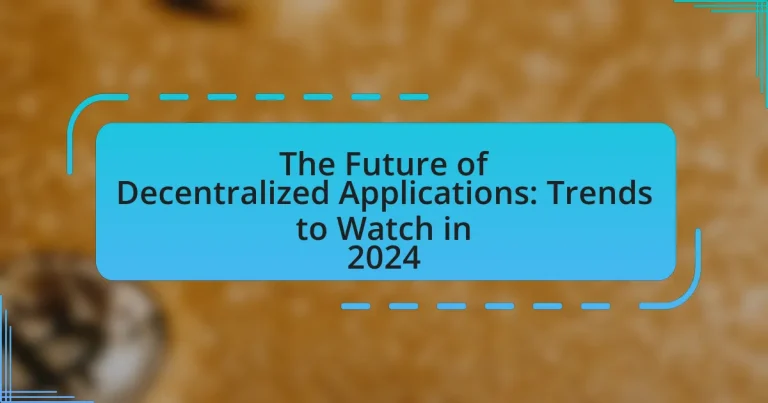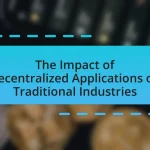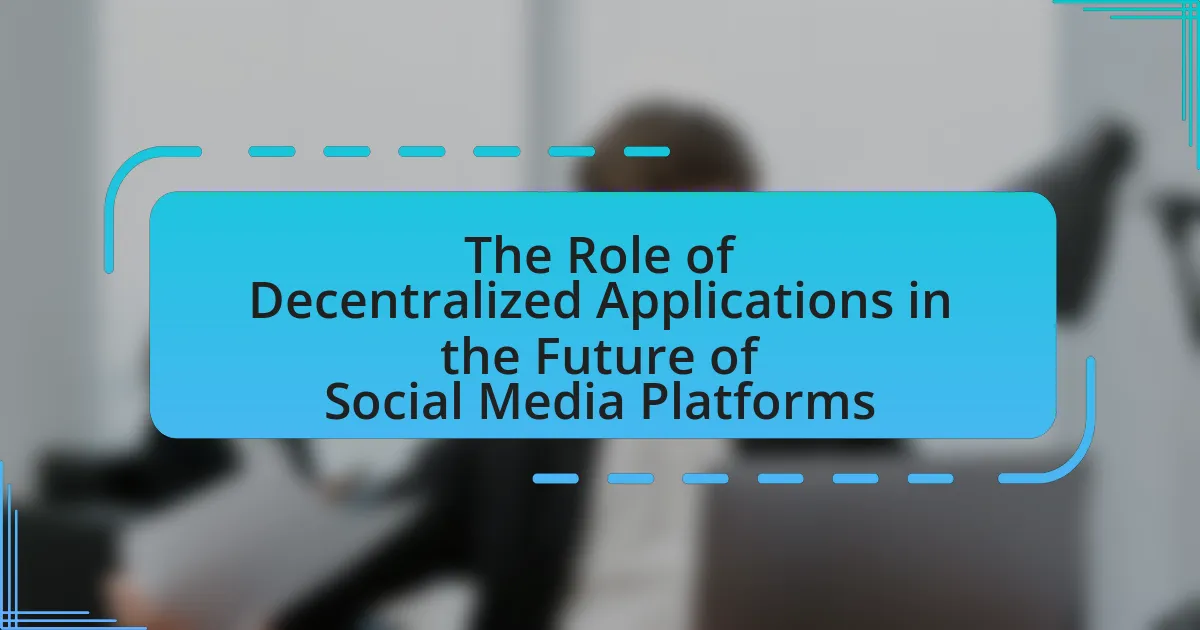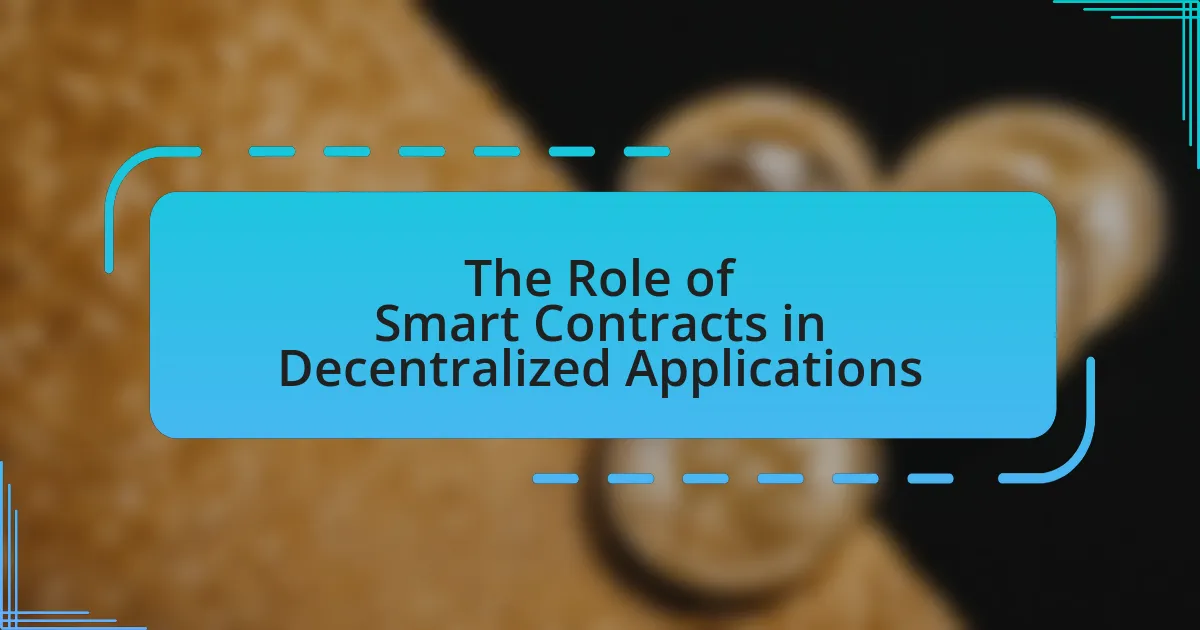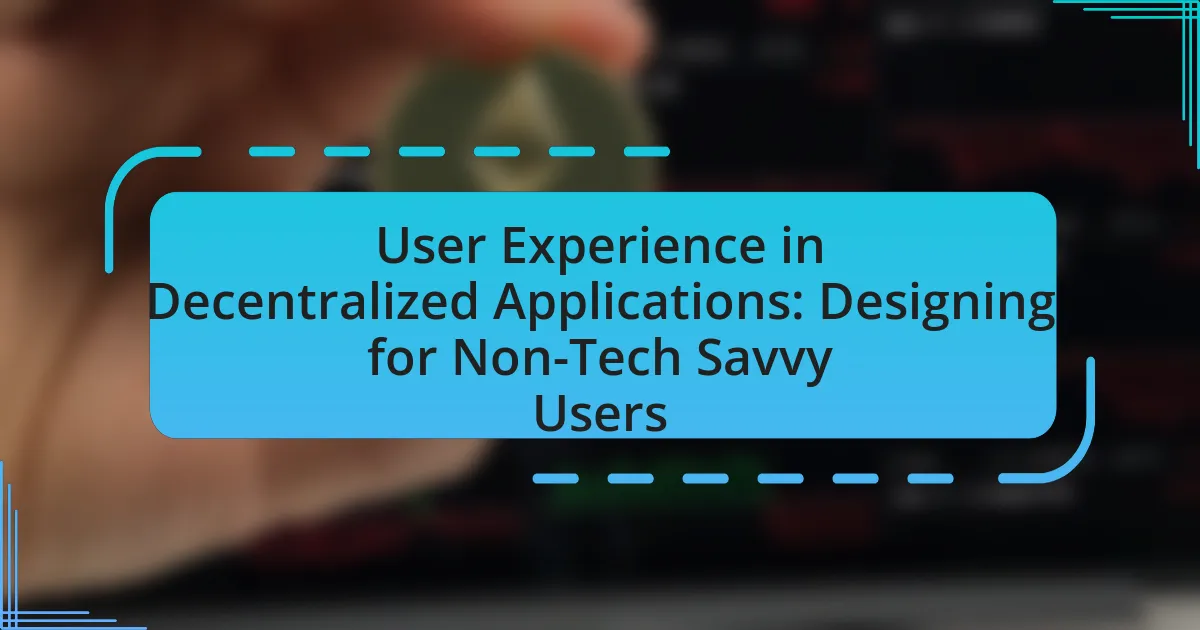Decentralized applications (dApps) are software applications that operate on blockchain or peer-to-peer networks, promoting transparency, security, and user control over data. This article explores the significance of dApps for the future, highlighting their differences from traditional applications, the technologies that underpin them, and the anticipated trends for 2024, including increased interoperability and enhanced user privacy. It also addresses the challenges dApps face, such as scalability and regulatory compliance, while outlining best practices for developers to ensure security and usability. Key trends in decentralized finance (DeFi) and non-fungible tokens (NFTs) are examined, along with the evolving user experience and the implications of government policies on dApp development.
What are Decentralized Applications and Why are They Important for the Future?
Decentralized applications (dApps) are software applications that run on a blockchain or peer-to-peer network, rather than being hosted on centralized servers. They are important for the future because they promote transparency, security, and user control over data, reducing reliance on centralized authorities. The rise of dApps is supported by the increasing adoption of blockchain technology, which is projected to grow significantly, with the global blockchain market expected to reach $163 billion by 2027, according to a report by Fortune Business Insights. This shift towards decentralization is crucial as it empowers users, enhances privacy, and fosters innovation across various sectors, including finance, supply chain, and social media.
How do decentralized applications differ from traditional applications?
Decentralized applications (dApps) differ from traditional applications primarily in their architecture and control mechanisms. While traditional applications are typically hosted on centralized servers and controlled by a single entity, dApps operate on a decentralized network, often utilizing blockchain technology, which distributes data across multiple nodes. This decentralization enhances security and reduces the risk of single points of failure, as evidenced by the resilience of blockchain networks against attacks compared to centralized systems. Additionally, dApps often incorporate smart contracts, enabling automated and trustless transactions, which contrasts with the reliance on intermediaries in traditional applications.
What technologies underpin decentralized applications?
Decentralized applications (dApps) are primarily underpinned by blockchain technology, which provides a distributed ledger for secure and transparent transactions. Additionally, smart contracts, which are self-executing contracts with the terms directly written into code, facilitate automated processes within dApps. Peer-to-peer networking is also essential, allowing direct interactions between users without intermediaries. Furthermore, decentralized storage solutions, such as IPFS (InterPlanetary File System), enable data to be stored across a network rather than on a single server, enhancing security and accessibility. These technologies collectively ensure that dApps operate in a decentralized, secure, and efficient manner.
Why is decentralization a key feature for future applications?
Decentralization is a key feature for future applications because it enhances security, promotes user autonomy, and fosters innovation. By distributing control across a network rather than relying on a central authority, decentralized applications reduce the risk of single points of failure and cyberattacks, as evidenced by the resilience of blockchain technology against hacking incidents. Furthermore, decentralization empowers users by giving them ownership of their data and decision-making processes, which aligns with growing consumer demand for privacy and control. This shift is supported by trends indicating that decentralized finance (DeFi) and non-fungible tokens (NFTs) are gaining traction, reflecting a broader movement towards user-centric models in technology.
What are the current trends in decentralized applications?
Current trends in decentralized applications include the rise of decentralized finance (DeFi), non-fungible tokens (NFTs), and increased interoperability among blockchain networks. DeFi platforms have seen significant growth, with total value locked in DeFi exceeding $80 billion in 2023, showcasing the demand for decentralized financial services. NFTs continue to gain traction, with the market reaching over $25 billion in sales in 2022, indicating a strong interest in digital ownership and collectibles. Additionally, projects focusing on cross-chain compatibility are emerging, allowing users to interact seamlessly across different blockchain ecosystems, which enhances user experience and expands the utility of decentralized applications.
How is blockchain technology influencing decentralized applications?
Blockchain technology is significantly influencing decentralized applications by providing a secure, transparent, and immutable framework for their development and operation. This technology enables decentralized applications to operate without a central authority, ensuring that data integrity and user control are maintained. For instance, Ethereum’s smart contracts allow developers to create decentralized applications that automatically execute transactions based on predefined conditions, enhancing trust and reducing the need for intermediaries. Furthermore, the rise of decentralized finance (DeFi) platforms illustrates how blockchain facilitates peer-to-peer transactions, enabling users to lend, borrow, and trade assets directly. This shift towards decentralization is supported by the increasing adoption of blockchain protocols, which are projected to grow, further driving innovation in decentralized applications.
What role do smart contracts play in the evolution of decentralized applications?
Smart contracts are fundamental to the evolution of decentralized applications (dApps) as they automate and enforce agreements without intermediaries. By executing code on blockchain platforms, smart contracts facilitate trustless transactions, ensuring that conditions are met before any action occurs. This capability enhances security and transparency, which are critical for user adoption and scalability of dApps. For instance, Ethereum’s smart contracts have enabled a wide range of applications, from decentralized finance (DeFi) to non-fungible tokens (NFTs), demonstrating their versatility and impact on the ecosystem.
What are the anticipated trends for decentralized applications in 2024?
Anticipated trends for decentralized applications in 2024 include increased interoperability, enhanced user privacy, and the rise of decentralized finance (DeFi) solutions. Interoperability will allow different blockchain networks to communicate seamlessly, fostering a more integrated ecosystem. Enhanced user privacy will be driven by advancements in zero-knowledge proofs and other privacy-preserving technologies, enabling users to maintain control over their data. The DeFi sector is expected to grow significantly, with more innovative financial products and services emerging, as evidenced by the rapid increase in total value locked (TVL) in DeFi protocols, which reached over $100 billion in 2023. These trends indicate a maturation of the decentralized application landscape, focusing on user-centric solutions and broader adoption.
How will user experience evolve in decentralized applications?
User experience in decentralized applications will evolve towards greater simplicity and accessibility. As decentralized technologies mature, user interfaces will become more intuitive, reducing the complexity often associated with blockchain interactions. For instance, advancements in wallet integrations and seamless onboarding processes will enable users to engage with decentralized applications without needing extensive technical knowledge. Additionally, the implementation of layer-2 solutions will enhance transaction speeds and lower costs, further improving user satisfaction. Research indicates that user-centric design principles are increasingly being adopted in the development of decentralized applications, leading to a more streamlined experience that caters to a broader audience.
What improvements can we expect in user interfaces for decentralized applications?
Improvements in user interfaces for decentralized applications will focus on enhanced usability, streamlined navigation, and increased accessibility. These advancements will likely include more intuitive design patterns that simplify complex blockchain interactions, making it easier for users to engage with decentralized platforms. Additionally, the integration of AI-driven personalization will tailor experiences to individual user preferences, further enhancing usability. Research indicates that user experience is a critical factor in the adoption of decentralized applications, with studies showing that improved interfaces can significantly increase user retention and satisfaction.
How will accessibility impact the adoption of decentralized applications?
Accessibility will significantly enhance the adoption of decentralized applications by enabling a broader range of users to engage with these platforms. When decentralized applications are designed with user-friendly interfaces and support for various accessibility tools, they can attract individuals with disabilities, those unfamiliar with blockchain technology, and users from diverse backgrounds. According to a report by the World Health Organization, over 1 billion people globally experience some form of disability, highlighting the importance of inclusive design in technology. By prioritizing accessibility, decentralized applications can tap into this large user base, ultimately driving higher adoption rates and fostering a more inclusive digital ecosystem.
What regulatory changes might affect decentralized applications in 2024?
Regulatory changes in 2024 may include stricter compliance requirements for decentralized applications (dApps) regarding data privacy, anti-money laundering (AML), and know your customer (KYC) regulations. Governments worldwide are increasingly focusing on regulating blockchain technology and cryptocurrencies to prevent illicit activities and protect consumers. For instance, the European Union’s Markets in Crypto-Assets (MiCA) regulation aims to create a comprehensive framework for crypto assets, which will directly impact how dApps operate within the EU. Additionally, the U.S. Securities and Exchange Commission (SEC) is expected to enhance its scrutiny of dApps that may offer securities, leading to potential legal challenges for developers. These evolving regulations will necessitate that dApp developers adapt their platforms to ensure compliance, thereby influencing the overall landscape of decentralized applications.
How could government policies shape the development of decentralized applications?
Government policies can significantly shape the development of decentralized applications by establishing regulatory frameworks that either encourage or hinder innovation. For instance, clear guidelines on data privacy, security, and compliance can foster a supportive environment for developers, as seen in jurisdictions like Switzerland, which has embraced blockchain technology through favorable regulations. Conversely, restrictive policies, such as stringent licensing requirements or outright bans on certain technologies, can stifle growth and deter investment, as evidenced by countries that have imposed heavy regulations on cryptocurrency exchanges. Thus, the nature of government policies directly influences the pace and direction of decentralized application development.
What are the implications of compliance for decentralized application developers?
Compliance for decentralized application developers entails navigating regulatory frameworks that can impact the design, functionality, and operation of their applications. Developers must ensure that their applications adhere to laws such as data protection regulations, anti-money laundering (AML) requirements, and consumer protection laws, which can vary significantly across jurisdictions. Failure to comply can result in legal penalties, loss of user trust, and potential shutdown of services. For instance, the General Data Protection Regulation (GDPR) in Europe mandates strict data handling practices, compelling developers to implement features that allow users to control their personal data. Thus, compliance not only shapes the technical architecture of decentralized applications but also influences market access and user adoption.
What challenges do decentralized applications face moving forward?
Decentralized applications face significant challenges moving forward, including scalability, user experience, and regulatory compliance. Scalability remains a critical issue as many blockchain networks struggle to handle increased transaction volumes without sacrificing speed or incurring high fees. For instance, Ethereum’s congestion during peak usage times has led to transaction costs exceeding $50, highlighting the need for more efficient solutions.
User experience is another challenge, as decentralized applications often require technical knowledge that can deter mainstream adoption. Complex interfaces and the necessity for users to manage private keys can create barriers, making it essential for developers to prioritize usability.
Regulatory compliance poses a further challenge, as governments worldwide are still defining how to regulate decentralized technologies. Uncertainty in regulations can hinder innovation and investment, as seen in the fluctuating legal status of cryptocurrencies in various jurisdictions.
These challenges must be addressed for decentralized applications to achieve widespread acceptance and functionality in the future.
How can scalability issues be addressed in decentralized applications?
Scalability issues in decentralized applications can be addressed through techniques such as sharding, layer-2 solutions, and improved consensus algorithms. Sharding involves partitioning the blockchain into smaller, manageable pieces, allowing for parallel processing of transactions, which significantly increases throughput. Layer-2 solutions, like state channels and rollups, enable off-chain transactions that reduce the load on the main blockchain while maintaining security and decentralization. Improved consensus algorithms, such as Proof of Stake, enhance transaction speed and energy efficiency compared to traditional Proof of Work systems. These methods have been validated by various blockchain projects, including Ethereum’s transition to Proof of Stake and the implementation of rollups, which have demonstrated substantial improvements in transaction capacity and speed.
What solutions are being proposed to enhance scalability?
Proposed solutions to enhance scalability in decentralized applications include layer 2 solutions, sharding, and improved consensus mechanisms. Layer 2 solutions, such as rollups, allow transactions to be processed off-chain, significantly increasing throughput while reducing congestion on the main blockchain. Sharding involves splitting the blockchain into smaller, manageable pieces, enabling parallel processing of transactions, which enhances overall network efficiency. Improved consensus mechanisms, like proof of stake, reduce the energy and time required for transaction validation, further supporting scalability. These methods are being actively researched and implemented to address the limitations of current blockchain infrastructures.
How do scalability challenges impact user adoption?
Scalability challenges significantly hinder user adoption by limiting the performance and responsiveness of decentralized applications. When applications cannot efficiently handle increased user demand, they experience slow transaction times and higher fees, which frustrate users and deter new ones. For instance, during peak usage periods, Ethereum has faced congestion, leading to transaction delays and costs that can exceed $50, as reported by various blockchain analytics platforms. This negative user experience directly correlates with decreased trust and interest in adopting the technology, as potential users often seek reliable and efficient alternatives.
What security concerns are associated with decentralized applications?
Decentralized applications (dApps) face several security concerns, primarily including smart contract vulnerabilities, data privacy issues, and the risk of network attacks. Smart contracts, which are self-executing contracts with the terms directly written into code, can contain bugs or exploits that malicious actors may leverage, leading to significant financial losses; for instance, the DAO hack in 2016 resulted in the theft of $60 million worth of Ether due to a vulnerability in its smart contract. Data privacy is another concern, as dApps often operate on public blockchains, making user data potentially accessible to anyone; this can lead to unauthorized data exposure. Additionally, decentralized networks can be susceptible to attacks such as Sybil attacks, where an attacker creates multiple identities to gain control over the network, undermining its integrity. These concerns highlight the need for robust security measures in the development and deployment of decentralized applications.
How can developers mitigate risks related to security in decentralized applications?
Developers can mitigate risks related to security in decentralized applications by implementing robust security protocols, conducting thorough code audits, and utilizing formal verification methods. These practices help identify vulnerabilities and ensure that the application behaves as intended. For instance, a study by the Blockchain Security Alliance found that regular security audits can reduce the likelihood of exploits by up to 80%. Additionally, employing multi-signature wallets and decentralized identity solutions can further enhance security by distributing control and minimizing single points of failure.
What are the most common vulnerabilities found in decentralized applications?
The most common vulnerabilities found in decentralized applications include smart contract bugs, inadequate access control, and oracle manipulation. Smart contract bugs, such as reentrancy attacks, can lead to significant financial losses, as evidenced by the DAO hack in 2016, which resulted in the loss of $60 million. Inadequate access control can allow unauthorized users to execute functions, compromising the integrity of the application. Oracle manipulation occurs when external data sources are compromised, affecting the reliability of the information used in smart contracts. These vulnerabilities highlight the critical need for rigorous security audits and best practices in decentralized application development.
What are the best practices for developing decentralized applications in 2024?
The best practices for developing decentralized applications in 2024 include prioritizing security, ensuring user privacy, and optimizing for scalability. Security is crucial as decentralized applications often handle sensitive data and assets; implementing robust cryptographic techniques and regular security audits can mitigate vulnerabilities. User privacy must be maintained by utilizing decentralized identity solutions and minimizing data collection, aligning with regulations like GDPR. Scalability can be achieved through layer-2 solutions and efficient consensus mechanisms, allowing applications to handle increased user demand without compromising performance. These practices are supported by industry trends emphasizing the importance of security and user-centric design in decentralized ecosystems.
How can developers ensure the usability of decentralized applications?
Developers can ensure the usability of decentralized applications by prioritizing user experience design and conducting thorough usability testing. Focusing on intuitive interfaces, clear navigation, and responsive design helps users interact seamlessly with the application. Additionally, incorporating user feedback during the development process allows developers to identify pain points and improve functionality. Research indicates that applications with user-centric designs see higher adoption rates; for instance, a study by Nielsen Norman Group found that usability improvements can lead to a 50% increase in user satisfaction.
What strategies can be employed to enhance security in decentralized applications?
To enhance security in decentralized applications, implementing robust cryptographic protocols is essential. These protocols, such as zero-knowledge proofs and end-to-end encryption, ensure that data remains confidential and secure from unauthorized access. Additionally, employing regular security audits and vulnerability assessments can identify and mitigate potential risks before they are exploited. Research indicates that decentralized applications utilizing multi-signature wallets significantly reduce the risk of unauthorized transactions, as they require multiple approvals for fund transfers. Furthermore, integrating decentralized identity solutions can enhance user authentication, minimizing the chances of identity theft.
